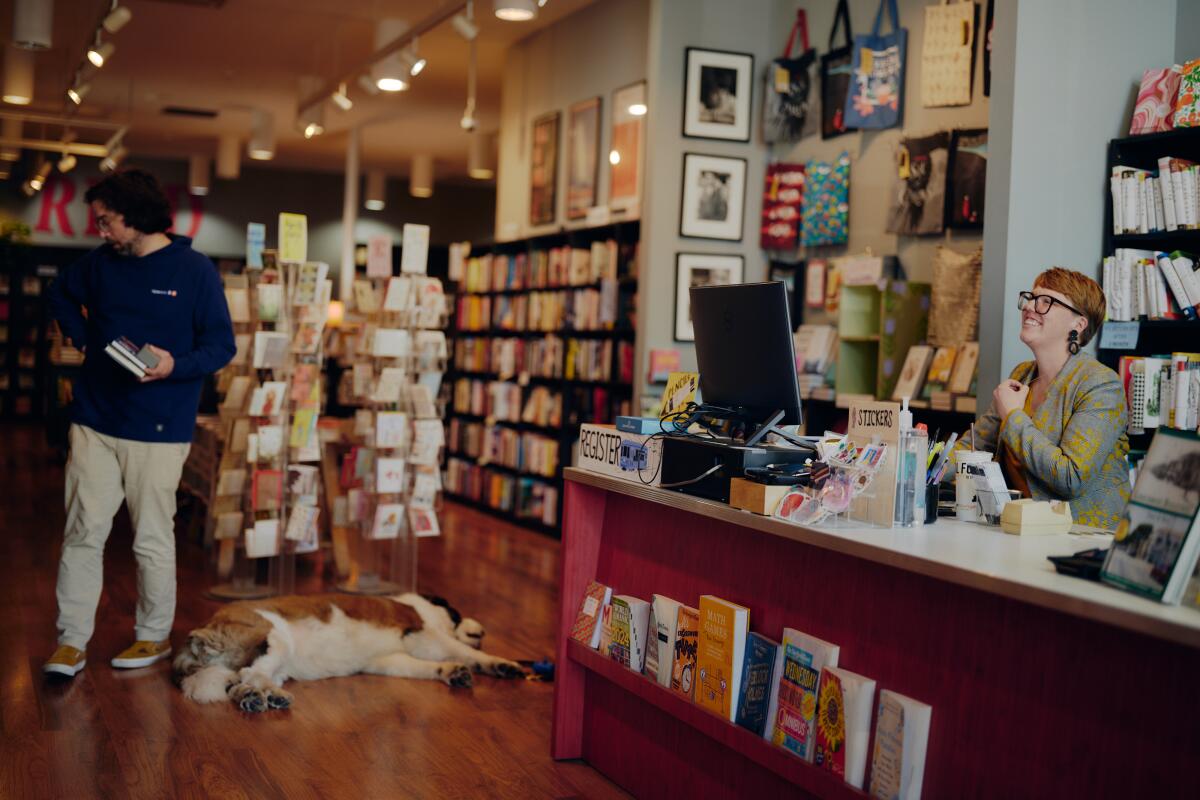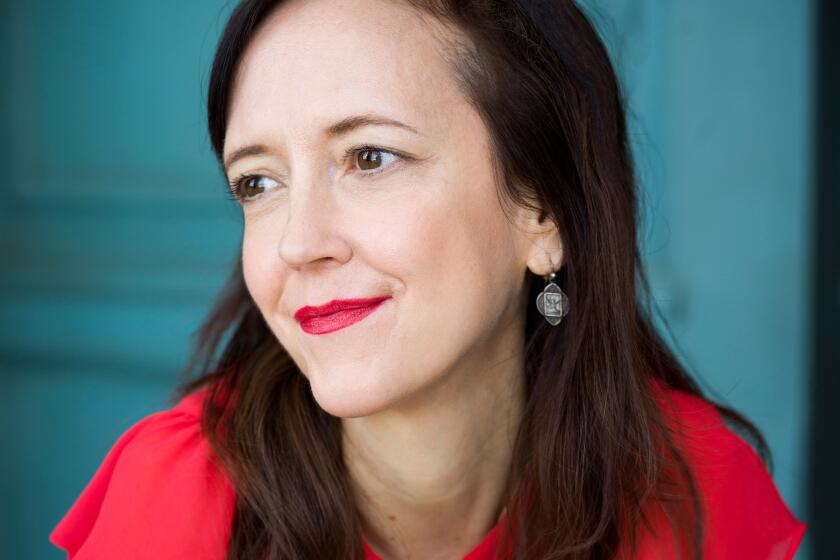Why this author wrote about creative women as they aged: ‘They made much of less’

Susan Gubar explains why she chose to write about women who entered a new creative phase as they aged in her new book, ‘Grand Finales.’ We also check in with Chevalier’s Books.
- Share via
In this week’s newsletter, we have a chat with Susan Gubar, whose new book, “Grand Finales: The Creative Longevity of Women Artists,” profiles seven creators who found a second wind in their advancing years. We also look at recent releases reviewed in The Times. And a local bookseller tells us what’s selling right now.
Seventeen years ago, Susan Gubar was handed a death sentence. A distinguished professor emerita of English and women’s studies at Indiana University and the co-author (with Sandra M. Gilbert) of 1979’s “The Madwoman in the Attic,” a groundbreaking work of feminist literary theory, Gubar in 2008 was staring down a terminal cancer diagnosis. A clinical trial involving an experimental drug prolonged her life and gave her the impetus to tackle a new project about seven artists — George Eliot, Colette, Georgia O’Keeffe, Isak Dinesen, Marianne Moore, Louise Bourgeois, Mary Lou Williams, Gwendolyn Brooks and Katherine Dunham — who entered a new phase of creative ferment and productivity as they grew older.
I talked to Gubar about her new book, the myth of old age and the persistent stereotypes attached to female artists who may be perceived as having outlived their usefulness as creators.
Any sort of creative activity involves expression, which is a great antidote to depression.
— Susan Gubar on why she writes
(Please note: The Times may earn a commission through links to Bookshop.org, whose fees support independent bookstores.)
✍️ Author Chat
Can you talk about how the book came about?
In 2008, I was told that I had 3-5 years to live with late-stage ovarian cancer. The standard treatment was ineffectual. But then in 2012, my oncologist encouraged me to enroll in a clinical trial that was experimenting with a new drug. After nine years in the trial, she then urged me to take “a drug holiday” since long-term use of the medication could cause leukemia. I am still on that holiday. An unanticipated old age made me appreciate the wonderful gifts longevity can bestow.
In researching your subjects, what do they all share in common?
All of my subjects are artists who experienced the losses of aging. They needed canes and wheelchairs and helpers while they suffered the pains of various diseases and regimens. One coped with blindness, another with deafness and still others with the loss of intimates. Yet in the face of such deficits, they used their art to exhibit their audacity, mojo, chutzpah, bravado. They’re exemplars of Geezer Machismo.
All of your subjects are women, who have a much tougher time in terms of earning respect and attention as they age. Can you speak to the obstacles they had to overcome as they reinvented themselves as artists in their advanced years?
The stereotypical old lady is invisible or risible, but we know that many elderly women thrive. My old ladies did not approach their life stories as prime-and-decline narratives. Instead they reinvented themselves. In part, they managed to do this by changing their objectives as artists. They moved from the stage to the page or from elite to popular forms. Some of them underwent religious or political conversions that energized their last years. They fully understood the losses of old age, but they did not settle for less. Instead, they made much of less.
What’s interesting about these artists is that — contrary, I must admit, to what I thought would have been the case — these women were supported by men who became their benefactors, and helped them to negotiate their careers.
Quite a few of the women that I write about were helped by much younger men in their lives, who became facilitators. This is true for George Eliot, Colette, Georgia O’Keeffe, Louise Bourgeoise, Mary Lou Williams and others. Williams, the great jazz pianist, was helped by a Jesuit named Father O’Brien, who helped her get control of her copyrights. Georgia O’Keeffe, in contrast, has been championed by photographer Alfred Stieglitz, but she had to leave him in her midlife to establish her autonomy late in life. He was very controlling, even though he definitely established her reputation. She was aided in her later years by a man young enough to be her grandson.
You are an octogenarian, and writing a book isn’t easy, as you know. Where do you find the inspiration and the strength to keep going as a creator?
What keeps me going is what kept my subjects flourishing in their seventies, eighties or nineties. Any sort of creative activity involves expression, which is a great antidote to depression. It may take the form of sculpting, painting, playing an instrument, teaching a dance routine, making a quilt or a garden, establishing a park or a prize, you name it. Without my two current writing projects, I’d be lost. Even (or maybe especially) in our dismal political climate, ongoing creative projects make each day an adventure.
📰 The Week(s) in Books

Heather Scott Partington reviews “Fox,” Joyce Carol Oates’ mystery novel about a murdered pedophile. “Fox has the bones of a potboiler but is supported by the sinew of the author’s elegant structure and syntax,” writes Partington .
Leigh Haber weighs in on Jess Walter’s book “So Far Gone,” calling the author a “slyly adept social critic [who has] clearly invested his protagonist with all of the outrage and heartbreak he himself feels about the dark course our world has taken.”
Daniel Felsenthal thinks Geoff Dyer’s memoir “Homework” is somewhat meandering, yet “bursts with working-class pride, a fond and mournful belief in the possibility of the British welfare state.”
And Paula L. Woods talked to five mystery writers about the inspirations for their new books.
📖 Bookstore Faves

This week, we’re talking about hot books with Nat Eastman, the manager of Chevalier’s Books on Larchmont Boulevard in Hollywood, the oldest independent bookstore in Los Angeles.
What books are selling in the store right now?
We’ve been moving Percival Everett’s “James” and Ocean Vuong’s “The Emperor of Gladness” hand over fist. Thanks to BookTok, Asako Yuzuki’s “Butter” has become a mainstay on our bestseller list. We also had the honor of hosting Bryan Byrdlong for a reading from his debut poetry collection “Strange Flowers,” and we’ve been handselling it right and left ever since.
What are your perennial sellers?
Kaya Doi’s series of picture books, “Chirri and Chirra,” is a smash hit around here. Joan Didion and bell hooks are reliable customer favorites as well. As an indie shop, though, we love the deeper cuts too — whether that’s “Água Viva,” literally any Yoko Ogawa work or something from our zine collection.
Are you seeing more young people buying books?
Despite all the reports about declining literacy rates among young folk, our children’s section makes up a quarter of our sales. We really try to carve out a space for the next generation of readers with programs like storytime, a middle-grade book club and summer-reading punch cards. To us, messy shelves are annoying everywhere except the kids’ section!
Sign up for our Book Club newsletter
Get the latest news, events and more from the Los Angeles Times Book Club, and help us get L.A. reading and talking.
You may occasionally receive promotional content from the Los Angeles Times.









